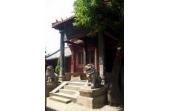Mange Buddhist
- Things to do
-
- Photo(12)
- Tips&article(4)
- Make it Happen
- Map
-
loading...
The Man Ge Buddhist Temple is also called "Wa Zha La Tan Man Ge" in the Dai language, which means the central Buddhist temple of Man Ge. Facing the east, the temple is very grand with wooden roof-beams, thick eaves and tiled-roof. The unique main temple is supported by sixteen red tree columns, which are 8-meter high and 40-cm thick.
All the roof-beams are Dou Gong style, which set brackets on top of the columns supporting the beams within and roof eaves without. There are also 16 elephant sculptures of the Qing dynasty being seated on the eaves. The whole temple is of beautiful shape without any nails or rivets. The statue of the Sakyamuni is located in the center of the hall, 1.
4 meters high and with the banner around it as fence which are of red bottom and yellow edge.
The BeiYe sutra kept in this temple before 1949 consists of 84,000 rolls including the content of literature, history, astronomy, calendar system, medical science, psychology, law, natural common sense, etc. The sutra was the crystallization of the Dai folk cultural arts.
The Dai people consider the day when the Buddha introduced in the area as the first year of the Dai calendar. By virtue of the resistance of the local primitive religion, the Buddhism was not stable until the 12th century and the 13th century. Then it thrived and many Buddhist temples including the Man Ge Buddhist Temple were built up.
The temple was built in the place that was 1km away from the present location around 840AD of the Dai calendar when the Hinayana Buddhism was very popular in Xi Shuang Ban Na. It was replaced in 1598, with the gold collected by the local government department and the Buddha believers. It had been repaired three times to the present scale until the middle of 16th century.
The temple has taken on a new look recently and attracted the tourists from both home and abroad with its resplendence and magnificence.
The Man Ge Buddhist Temple is the most ancient temple architecture of Jung Hong city and has an upper status and fame in society especially the religious circles because the Local Buddhist believers, the Buddhist monks, the most powerful feudal aristocracy and the local department of publicity donate the money it needed.
Tips & articles
|
|
|
forum discussion
|










